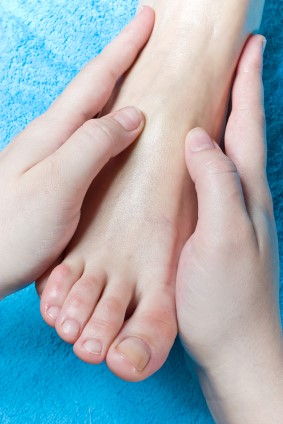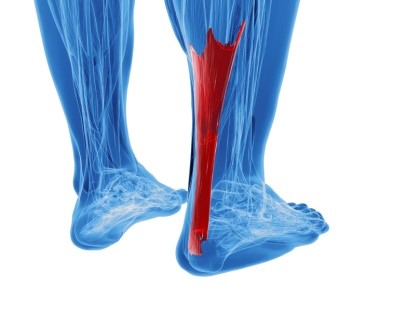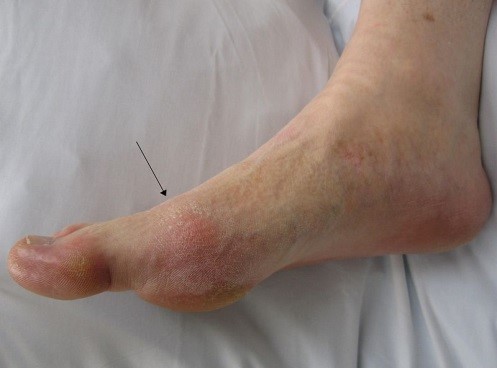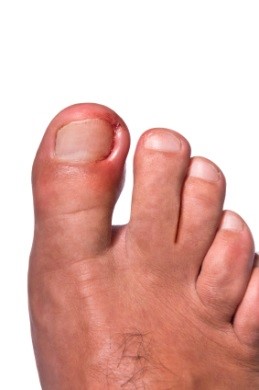Featured Articles
Items filtered by date: September 2014
Pain in Toes Aided by Innovative Implant Technology
 Cartiva is an implant that could help ease the pain and stiffness from arthritis. To prevent the toes from rubbing together while lowering the pain, the implant is inserted between the bones of the toe via surgical means. Cartiva’s flexibility and putty-like consistency allow it to act like cartilage and absorbing shock. Val Cornwall, a sixty-seven-year-old resident of Hillingdon, Middlesex underwent surgery for the procedure in February 2011 and is now as active as ever. About a half million people in Britain suffer from arthritis in their big toe.
Cartiva is an implant that could help ease the pain and stiffness from arthritis. To prevent the toes from rubbing together while lowering the pain, the implant is inserted between the bones of the toe via surgical means. Cartiva’s flexibility and putty-like consistency allow it to act like cartilage and absorbing shock. Val Cornwall, a sixty-seven-year-old resident of Hillingdon, Middlesex underwent surgery for the procedure in February 2011 and is now as active as ever. About a half million people in Britain suffer from arthritis in their big toe.
If left untreated, arthritis of the feet—especially the big toe—can be very painful. If painful arthritis has been troubling you, consult with Dr. Sharon Pletcher of Pennsylvania. Dr. Pletcher will provide you with quality foot and ankle treatment and alleviate your joint pain.
Arthritic Foot Care
In an average lifetime, we walk approximately 75,000 miles. This can put a great deal of stress on the 26 bones and 30 joints that we have in our feet. As we get older, our feet lose flexibility and elasticity. Our shock absorbers weaken, and if arthritis comes into play, the joints become inflamed and distorted. Arthritic foot care and treatment would become imperative at this point.
It is best to take care of your feet by wearing well-fitted shoes. Certain conditions may develop when you wear shoes that don’t fit properly, for example hammertoes, neuroma, and bunions. Wearing shoes that have a lower heel and extra room in the shoe can help your feet be comfortable. In cases of rheumatoid arthritis, the arch in your foot may become problematic. Buying shoes with arch support will help; it is also a good idea to buy shoes that contour to your foot.
Alleviating Arthritic Pain
-Specific exercises may help; stretching the Achilles tendon can prevent further pain and injury. Stretching can also increase your mobility.
For more information about Arthritic Foot Care, follow the link below.
If you have any questions, please feel free to contact our office located in State College, PA. We offer the newest diagnostic and treatment technologies for all your foot care needs.
Read more about Arthritic Foot Care
Arthritic Foot Care
In our lifetimes we walk 75,000 miles, putting a great deal of stress on the 26 bones and 30 joints in our feet. As we age, our feet lose flexibility and elasticity. Our shock absorbers weaken, and if you add arthritis to that combination, joints become inflamed and distorted. Arthritic foot care becomes imperative at this point.
Start taking better care of your feet by buying better fitting shoes. Hammertoes, neuroma, and bunions form when our shoes fit poorly. Buy shoes with a lower heel and with more room in the shoe. Rheumatoid arthritis will cause you to lose your arch. Buying shoes with arch support will help, as will buying shoes that contour to your foot.
Leave a fingers width between your foot and the shoe. If your finger cannot fit inside your shoe when it is on your foot, it is too tight. Buy rubber soled shoes. The cushioning of the rubber absorbs shock and the flexibility of the rubber helps the ball of the foot, where you push off from as you walk. Look for square or rounded toed shoes giving your toes lots of room to move.
Exercise will also help. Stretching the Achilles tendon, the cord at the back of the heel, will prevent further pain and injury. This will also increase your foots mobility. Lack of mobility will cause significant stress and pain. Massages will also alleviate some pain. Knead the ball of your foot and your toes from top to bottom.
To stretch your Achilles tendon, lean against a wall, with palms flat on the wall. Place one foot forward and one foot back with the heel flat on the floor, then lean forward. Feel the pull in the Achilles tendon and calf. Hold for five seconds and repeat three times. The big toe stretch is another exercise that may alleviate stiffness. Place one thick rubber band around your big toes. Pull the toes toward the other toes on the foot. Hold for five seconds and repeat ten times. Another exercise to try is the toe pull. Place a thick rubber band around the toes of each foot. Spread your toes for five seconds and repeat ten times.
Pain can be alleviated with non-steroid, anti-inflammatory drugs, heat, and ultrasounds. Topical medications with Capsaicin may also help. Thus far, there is no remedy for pain that is one hundred percent effective. Buying shoes that give your feet plenty room with low rubber heels and soles will help. If needed, use heat and anti-inflammatory drugs, and exercise your tendons and toes. Lastly, arthritic foot care should incorporate massages to help your feet with circulation and to relieve the stress locked up in your feet.
Runners May Reduce Tendon Injuries with Orthotics
 Dr. Jonathan Sinclair of the University of Central Lancashire participated in a study concerning runners and Achilles tendon injury. The study found that people who wear orthotics while running could prevent the possibility of Achilles injury. Sinclair used 12 male participants and had them run on a mat with sensors that measured the movement of the foot.
Dr. Jonathan Sinclair of the University of Central Lancashire participated in a study concerning runners and Achilles tendon injury. The study found that people who wear orthotics while running could prevent the possibility of Achilles injury. Sinclair used 12 male participants and had them run on a mat with sensors that measured the movement of the foot.
The study showed that the runners wearing the orthotics were less apt to Achilles tendon injury because of the ease of pressure the insoles provided to the foot. “This probably happens because orthotics offer further cushioning to that already provided by the shoe midsole,” Dr. Sinclair said.
Achilles tendon injuries can be very painful. If you think you have this kind of condition, pay a visit to podiatrist Dr. Sharon Pletcher of Pennsylvania. Dr. Pletcher can treat your foot and ankle needs.
What is the Achilles Tendon?
The Achilles tendon is a tendon that connects the lower leg muscles and calf to the heel of the foot. It is the strongest tendon in the human body, and is essential for making movement possible. Because this tendon is such an integral part of the body, any injuries to it can cause severe difficulties and should immediately be presented to a doctor.
What are the symptoms of an Achilles Tendon Injury?
There are various types of injuries that can affect the Achilles tendon. The two most common are Achilles tendinitis and ruptures of the tendon.
Achilles Tendinitis Symptoms
- Inflammation
- Dull to Severe Pain
- Increased blood flow to the tendon
- Thickening of the tendon
Rupture Symptoms
- Extreme pain and swelling in the foot
- Total immobility
Treatment and Prevention
Achilles tendon injuries are diagnosed by a thorough physical evaluation. Often the doctor will order an MRI to confirm the diagnosis. Treatment will involve rest, physical therapy, and in some cases, surgery. However, various preventative measures can be taken to avoid these injuries.
For more information about Achilles Tendon Injuries, follow the link below.
If you have any questions, please feel free to contact our office located in State College, PA. We offer the newest diagnostic and treatment technologies for all your foot care needs.
Read more about Achilles Tendon Injuries
Gout More Likely to Occur during Certain Temperatures
 Students at Boston University School of Medicine conducted research experiment that shows a correlation between high temperatures and the reoccurrence of gout attacks. The head scientist, Tuhina Neogi, MD, PhD, and other faculty members started by gathering data from over 600 patients with suffering from gout using a questionnaire. The ages of the patients ranged from 21 – 88.
Students at Boston University School of Medicine conducted research experiment that shows a correlation between high temperatures and the reoccurrence of gout attacks. The head scientist, Tuhina Neogi, MD, PhD, and other faculty members started by gathering data from over 600 patients with suffering from gout using a questionnaire. The ages of the patients ranged from 21 – 88.
According to the data, it was discovered that temperatures of 70°-79° F were associated with a 43% increase of a potential gout attack occurring. When the temperature reached over 80° F the risk changed to 40%. Following their findings, researchers stated, “Patients with gout may be advised that under conditions of hot and/or dry weather, appropriate measures, such as increased water intake, should be considered to minimize the risk of recurrent gout attacks.”
The severity of gout attacks can vary, but they should always be granted proper medical care. For assistance with a foot condition like gout, contact Dr. Sharon Pletcher, DPM of Pennsylvania. Dr. Pletcher can figure out why you keep getting flare-ups and work with you to treat the root of the problem.
What is gout?
Diseases of the feet can affect the whole body, and symptoms usually arise within the feet. A condition like gout can make a patient’s ability to walk unbearable. The pain caused by this disease is often so agonizing that it requires elevation of the feet and some time off for them to fully recover.
Known in the past as “the disease of kings”, Gout is caused by an excess of uric acid in the body. Some common symptoms include pain, inflammation, and redness at the metatarsal/phalangeal joint of the base big toe. This buildup of acid is typically seen on the big toe of the foot and can cause inflammation, redness and swelling. Although these are common symptoms of the diseases others include joint pain, extreme fatigue and a high fever.
Gout can be treated by NSAIDs, which relieves pain and inflammation and other drugs which lowers the acid levels in the body.
If you have any questions please contact our office located in State College, PA. We offer the newest diagnostic and treatment technologies for all your foot care needs.
Read more about Gout
What is Gout?
Gout is a form of arthritis that is unusually painful. A slight touch can send shooting pain. The most common area for gout to occur is in the metatarsal phalangeal joint of the big toe. Other areas of the body frequently affected by gout are the knees, elbows, fingers, ankles and wrists.
Gout occurs when there are elevated levels of uric acid in the blood. This condition is called hyperuricemia. Hyperuricemia is a genetically pre-disposed condition about 90% of the time and occurs because the kidneys do not produce the correct amount of uric acid. Children of parents who have had gout will have a 20% chance of developing it themselves. The excess uric acid in the blood forms crystals that deposit in between joints causing friction with movement.
Symptoms of gout caused by this friction include pain, redness, swelling, and inflammation. Fever and fatigue may occur as well, although these symptoms are rare. The pain can be worse during the night when the body’s temperature lowers.
Gout can be diagnosed clinically by a doctor’s observation of the redness, swelling, and pain. More definitive tests can be performed by the doctor as well. Blood tests check for elevated uric acid levels in the blood. The synovial fluid in the joint can also be withdrawn through a needle to be checked for uric acid crystals. Chronic gout can be diagnosed by X-ray.
Treatment given for acute gout diminishes the symptoms. Non-steroid anti-inflammatory drugs such as Colchicine and other corticosteroid drugs will stop the swelling, redness, and inflammation in cases of acute gout. If gout becomes chronic, there are multiple ways to combat it. Lifestyle changes and changes in diet may be necessary, as well as preventative drugs.
Gout can be aggravated by a sedentary lifestyle. Exercise will reduce probability of future cases of gout. Certain foods cause or increase the risk of gout and their consumption should be avoided or kept at a minimum. These foods include red meat, alcohol, sea foods, and drinks sweetened with fructose.
Lifestyle changes and diet that help prevent gout include exercise and certain foods that help decrease the chance of gout recurring. Gout preventative foods include Vitamin C, coffee and some dairy products. New drugs have been discovered that inhibit the body’s production of certain enzymes. These are the enzymes that produce uric acid. Lowering your levels of uric acid will greatly reduce the chances of developing further cases of gout.
Women’s Chances of Developing RA Increase From Drinking Soda
 The Nurses’ Health Study and the Nurses’ Health Study II both indicate that a woman’s chances of developing a form of rheumatoid arthritis (RA) increase by 63% if she consumes soda on a regular basis. Alarmingly, this increase spikes up to 164% if the patient happens to be over the age of 55.
The Nurses’ Health Study and the Nurses’ Health Study II both indicate that a woman’s chances of developing a form of rheumatoid arthritis (RA) increase by 63% if she consumes soda on a regular basis. Alarmingly, this increase spikes up to 164% if the patient happens to be over the age of 55.
The first NHS study involved 79,000 American women, while the second NHS study consisted of 107,330. The participants involved in the study were asked every four years about how often they drank soda. The data did not show any correlation between drinking diet soda and contracting RA.
Rheumatoid arthritis is a very painful disease. For foot and ankle care, visit podiatrist Sharon L. Pletcher, DPM of Family Foot Center. Dr. Pletcher can treat your podiatric needs.
What Is Rheumatoid Arthritis?
Rheumatoid Arthritis (RA) is an autoimmune disorder in which the body’s own immune system attacks the membranes surrounding the joints. Inflammation of the lining and eventually the destruction of the joint’s cartilage and bone occurs, causing severe pain and immobility.
Rheumatoid Arthritis of the Feet
Although RA usually attacks multiple bones and joints throughout the entire body, almost 90 percent of cases result in pain in the foot or ankle area. Pain often initially presents in the toes before the condition worsens and spreads throughout the entire foot. Rheumatoid arthritis appears to be genetically inherited, so if you have a family history of RA, you may be predisposed to suffer from it as well.
Symptoms
- Swelling & pain in the feet
- Stiffness in the feet
- Pain on the ball or sole of feet
Diagnosis
Quick diagnosis of RA in the feet is important so that the podiatrist can treat the area effectively. Your doctor will ask you about your medical history, occupation, and lifestyle to determine the origin of the condition.
For more information about Rheumatoid Arthritis, follow the link below.
If you have any questions, please feel free to contact our office located in State College, PA. We offer the newest diagnostic and treatment technologies for all your foot and ankle injuries.
Read more about Rheumatoid Arthritis
Ingrown Toenails Happen to Kids Too
 Parents need to know that kids are just as susceptible in developing ingrown toenails in their feet as adults do. Ingrown toenails generally happen when kids cut their nails too short. Parents should ensure their children cut their nails evenly and avoid trimming them down too much. Ingrown nails could potentially occur if a child wears socks and shoes that aren’t big enough for his or her feet.
Parents need to know that kids are just as susceptible in developing ingrown toenails in their feet as adults do. Ingrown toenails generally happen when kids cut their nails too short. Parents should ensure their children cut their nails evenly and avoid trimming them down too much. Ingrown nails could potentially occur if a child wears socks and shoes that aren’t big enough for his or her feet.
Other cases of ingrown toenails may simply caused by a child’s genetic predisposition to curved nails. No matter what the cause, you should never try to treat this condition at home. Removing a young one’s ingrown nail with a “bathroom surgery” can lead to a bacterial infection.
Ingrown toenails are terribly uncomfortable, and in the worst cases surgery might be required to get rid of them. If you think you have an ingrown toenail, consult with Sharon L. Pletcher, DPM of Family Foot Center. Dr. Pletcher will confirm your diagnosis and do everything she can to treat your problem.
Ingrown Toenails Causes
Ingrown toenails occur when a toenail grows sideways into the bed of the nail, causing pain, swelling, and possibly infection.
There are a number of risk factors for ingrown toenails. Some include cutting your nails too short, participating in strenuous sports, diabetes, obesity, and fungal infection. Some are genetically predisposed to ingrown nails, although wearing ill-fitting or damp shoes can exacerbate the problem.
Treatment
There are a number of steps you can take to treat ingrown nails:
-Let your toenails grow out
-Soak the toes in hot water with antibiotic soap or Epsom salts
-Placing a piece of cotton under the affected nail may allow the toe to grow up instead of into the nail bed
-Rest with your feet up
If however, your pain is severe, or you see red streaks running up your leg, you should see a podiatrist. Your podiatrist may make a small incision and remove part of the toe nail to relieve the pressure. A local anesthetic may be used to lessen the discomfort of the operation. Topical medication may also be prescribed to prevent the regrowth of the problem nail.
If you have any questions, please feel free to contact our office located in State College, PA. We offer the newest diagnostic and treatment technologies for all your foot and ankle injuries.
Read more about Ingrown Toenails




